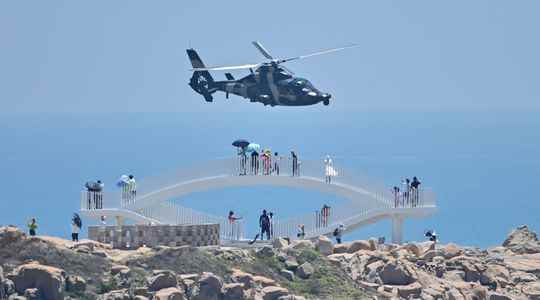The staging is worthy of a Hollywood movie. At noon sharp, Beijing time this Thursday, August 4, the day after a visit by Nancy Pelosi, the speaker of the United States House of Representatives – experienced as an affront by the communist regime – dozens of vehicles equipped with rocket launchers open fire in the direction of Taiwan (but do not hit the island), and Dongfeng ballistic missiles are fired into the surrounding waters. Swarms of fighter planes take off simultaneously from air bases in Fujian province under the eye of television cameras which broadcast these maneuvers described as “historic” on a loop.
A People’s Army general describes, straight as an “i”, the military arsenal deployed by China: J-20 stealth fighters, nuclear-capable Xian H-6 bombers, a dozen ” Dongfeng” and, the highlight of the “show”, the medium-range hypersonic DF17 missile capable of striking the heart of Taiwan. 14 meters long, it can fly at low altitude and thus escape anti-missile systems.
But it is in the China Sea that the operation is most impressive. Hundreds of ships, destroyers, helicopter carriers, aircraft carriers and amphibious vehicles are positioned in six specific areas encircling the island of Taiwan, sometimes less than 20 kilometers from its coast, flirting dangerously with the territorial limits of the island. . “The objective, explains General Zhang of the naval school of the Chinese army on television sets, is to show that the People’s Army is capable of controlling all the accesses to the island of Taiwan, which will be very dissuasive for the secessionist and separatist forces of the island”.
“Unprecedented encirclement”
The message is clear: Beijing is capable of cutting Taiwan off from the rest of the planet. In other words, to subject the island to a blockade. “This exercise is very different from the previous ones, explains Meng Xiangqing, professor at the Chinese University of National Defense. In the past, our exercises against the independence of Taiwan were generally carried out near the mainland. This time, they are take place very close to the island of Taiwan. By observing the six zones of these maneuvers, we see that it is indeed a question of carrying out an unprecedented encirclement of the island”.
And in fact, no more ships are circulating along the Strait of Formosa, one of the busiest waterways in the world where 90% of the giant container ships on the planet pass, according to a count by the Bloomberg agency. Taiwanese ports are inaccessible. And already, some are worried about a shortage of gas and oil on the island. The airlines, for their part, received an alert message asking them not to fly over the area until Sunday noon.
The operation clearly aims to symbolize the rise of the Chinese navy since the last Taiwan Strait crisis in 1995-1996, which saw the United States send a large military fleet, after Chinese missile fire . “The balance of forces present is completely different, assures Oriana Skylar Mastro, researcher at Stanford University. The Chinese fleet was very late, only a tiny proportion of its equipment was modern, there was no defense systems. Whereas today, the majority of Chinese ships are as advanced as those of the United States. And their fighter planes can now fly at night and in difficult weather conditions, which was not the case before”.
Reliance on Taiwanese semiconductors
The latest Pentagon report shows 355 ships and submarines on the Chinese side – more than the US fleet – and forecasts 420 by 2025. Since 2019, China has started building its own aircraft carriers – it now has three – and has equipped herself with two amphibious assault ships. A third is under construction. “China is rapidly catching up with Western forces,” said the Pentagon.
In the light of these maneuvers carried out since this Thursday, August 4, the Chinese strategy in relation to Taiwan – which Beijing considers to be part of its territory – does not seem to relate directly to an invasion of the island, nor to a landing, ” too costly, in terms of manpower, material and political risk,” said researcher Oriana Skylar Mastro. Xi Jinping seems to prefer a blockade of the island. “Cut off from the rest of the world, Taiwan will fall like a ripe fruit,” comments a Chinese journalist, on Weibo, the Chinese Twitter.
The Chinese army, as of Thursday, described this first day of exercise as “successful”, considering that the operations to block the island were intended to become a “routine”, according to political upheavals. Problem, the island represents half of the world’s production of chips that are essential to the operation of mobile phones, consumer electronics, cars or military equipment. South Korea, its closest competitor, barely holds 17% of the market. Suffice to say that a prolonged blockade of Taiwan would cause a cataclysm for the world economy.
“Taiwan and its semiconductors are far more important to the US economy than Ukraine, which means it would most likely be far more difficult for the US to stay out of a conflict involving Taiwan,” says Martijn Rasser, a former American intelligence officer and researcher at the “Center for a New American Security”. While in Beijing, the Taiwan question is waved like a nationalist torch; this blockade is a very serious warning for the government of the island.
